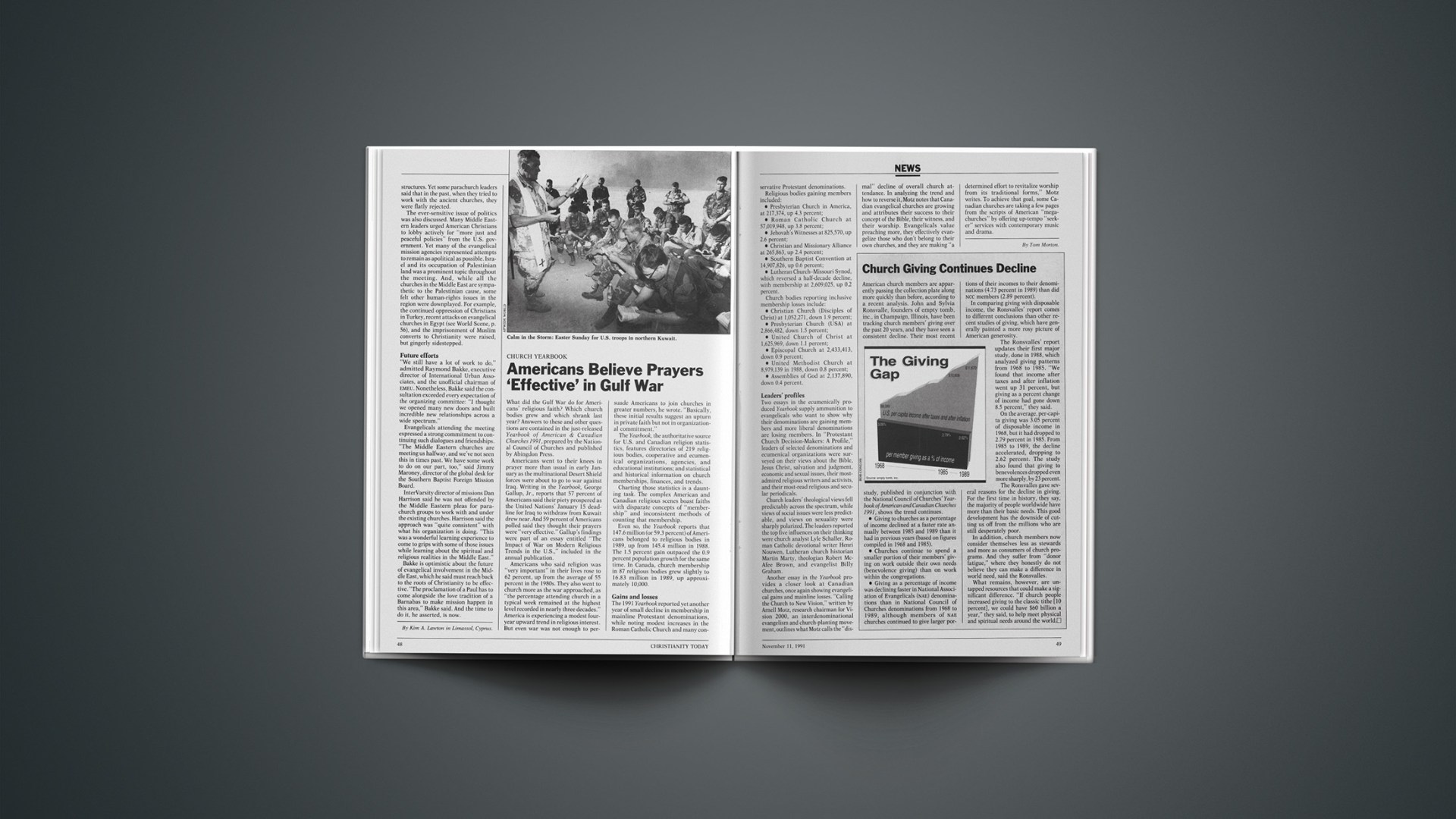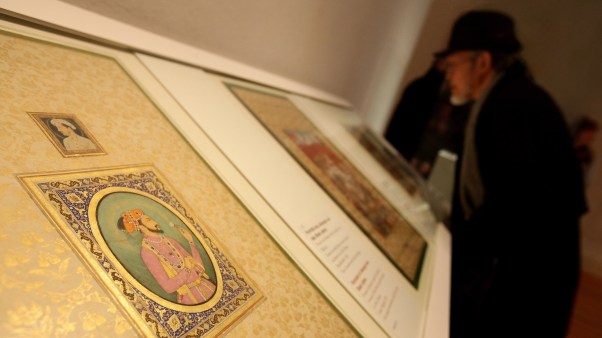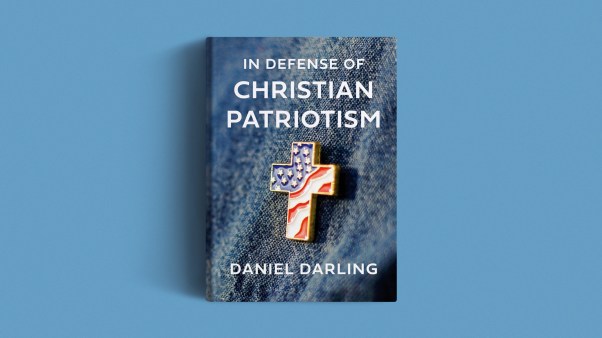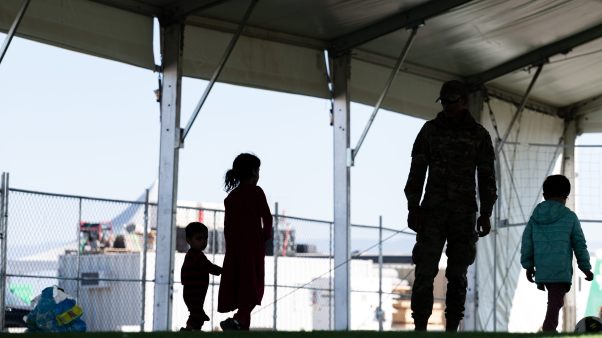What did the Gulf War do for Americans’ religious faith? Which church bodies grew and which shrank last year? Answers to these and other questions are contained in the just-released Yearbook of American & Canadian Churches 1991, prepared by the National Council of Churches and published by Abingdon Press.
Americans went to their knees in prayer more than usual in early January as the multinational Desert Shield forces were about to go to war against Iraq. Writing in the Yearbook, George Gallup, Jr., reports that 57 percent of Americans said their piety prospered as the United Nations’ January 15 deadline for Iraq to withdraw from Kuwait drew near. And 59 percent of Americans polled said they thought their prayers were “very effective.” Gallup’s findings were part of an essay entitled “The Impact of War on Modern Religious Trends in the U.S.,” included in the annual publication.
Americans who said religion was “very important” in their lives rose to 62 percent, up from the average of 55 percent in the 1980s. They also went to church more as the war approached, as “the percentage attending church in a typical week remained at the highest level recorded in nearly three decades.” America is experiencing a modest four-year upward trend in religious interest. But even war was not enough to persuade Americans to join churches in greater numbers, he wrote. “Basically, these initial results suggest an upturn in private faith but not in organizational commitment.”
The Yearbook, the authoritative source for U.S. and Canadian religion statistics, features directories of 219 religious bodies, cooperative and ecumenical organizations, agencies, and educational institutions; and statistical and historical information on church memberships, finances, and trends.
Charting those statistics is a daunting task. The complex American and Canadian religious scenes boast faiths with disparate concepts of “membership” and inconsistent methods of counting that membership.
Even so, the Yearbook reports that 147.6 million (or 59.3 percent) of Americans belonged to religious bodies in 1989, up from 145.4 million in 1988. The 1.5 percent gain outpaced the 0.9 percent population growth for the same time. In Canada, church membership in 87 religious bodies grew slightly to 16.83 million in 1989, up approximately 10,000.
Gains And Losses
The 1991 Yearbook reported yet another year of small decline in membership in mainline Protestant denominations, while noting modest increases in the Roman Catholic Church and many conservative Protestant denominations.
Religious bodies gaining members included:
• Presbyterian Church in America, at 217,374, up 4.3 percent;
• Roman Catholic Church at 57,019,948, up 3.8 percent;
• Jehovah’s Witnesses at 825,570, up 2.6 percent;
• Christian and Missionary Alliance at 265,863, up 2.4 percent;
• Southern Baptist Convention at 14,907,826, up 0.6 percent;
• Lutheran Church-Missouri Synod, which reversed a half-decade decline, with membership at 2,609,025, up 0.2 percent.
Church bodies reporting inclusive membership losses include:
• Christian Church (Disciples of Christ) at 1,052,271, down 1.9 percent;
• Presbyterian Church (USA) at 2,866,482, down 1.5 percent;
• United Church of Christ at 1,625,969, down 1.1 percent;
• Episcopal Church at 2,433,413, down 0.9 percent;
• United Methodist Church at 8,979,139 in 1988, down 0.8 percent;
• Assemblies of God at 2,137,890, down 0.4 percent.
Leaders’ Profiles
Two essays in the ecumenically produced Yearbook supply ammunition to evangelicals who want to show why their denominations are gaining members and more liberal denominations are losing members. In “Protestant Church Decision-Makers: A Profile,” leaders of selected denominations and ecumenical organizations were surveyed on their views about the Bible, Jesus Christ, salvation and judgment, economic and sexual issues, their most-admired religious writers and activists, and their most-read religious and secular periodicals.
Church leaders’ theological views fell predictably across the spectrum, while views of social issues were less predictable, and views on sexuality were sharply polarized. The leaders reported the top five influences on their thinking were church analyst Lyle Schaller, Roman Catholic devotional writer Henri Nouwen, Lutheran church historian Martin Marty, theologian Robert McAfee Brown, and evangelist Billy Graham.
Another essay in the Yearbook provides a closer look at Canadian churches, once again showing evangelical gains and mainline losses. “Calling the Church to New Vision,” written by Arnell Motz, research chairman for Vision 2000, an interdenominational evangelism and church-planting movement, outlines what Motz calls the “dismal” decline of overall church attendance. In analyzing the trend and how to reverse it, Motz notes that Canadian evangelical churches are growing and attributes their success to their concept of the Bible, their witness, and their worship. Evangelicals value preaching more, they effectively evangelize those who don’t belong to their own churches, and they are making “a determined effort to revitalize worship from its traditional forms,” Motz writes. To achieve that goal, some Canadian churches are taking a few pages from the scripts of American “megachurches” by offering up-tempo “seeker” services with contemporary music and drama.
By Tom Morton.
Church Giving Continues Decline
American church members are apparently passing the collection plate along more quickly than before, according to a recent analysis. John and Sylvia Ronsvalle, founders of empty tomb, inc., in Champaign, Illinois, have been tracking church members’ giving over the past 20 years, and they have seen a consistent decline. Their most recent study, published in conjunction with the National Council of Churches’ Yearbook of American and Canadian Churches 1991, shows the trend continues.
• Giving to churches as a percentage of income declined at a faster rate annually between 1985 and 1989 than it had in previous years (based on figures compiled in 1968 and 1985).
• Churches continue to spend a smaller portion of their members’ giving on work outside their own needs (benevolence giving) than on work within the congregations.
• Giving as a percentage of income was declining faster in National Association of Evangelicals (NAE) denominations than in National Council of Churches denominations from 1968 to 1989, although members of NAE churches continued to give larger portions of their incomes to their denominations (4.73 percent in 1989) than did NCC members (2.89 percent).
In comparing giving with disposable income, the Ronsvalles’ report comes to different conclusions than other recent studies of giving, which have generally painted a more rosy picture of American generosity.
The Ronsvalles’ report updates their first major study, done in 1988, which analyzed giving patterns from 1968 to 1985. “We found that income after taxes and after inflation went up 31 percent, but giving as a percent change of income had gone down 8.5 percent,” they said.
On the average, per-capita giving was 3.05 percent of disposable income in 1968, but it had dropped to 2.79 percent in 1985. From 1985 to 1989, the decline accelerated, dropping to 2.62 percent. The study also found that giving to benevolences dropped even more sharply, by 23 percent.
The Ronsvalles gave several reasons for the decline in giving. For the first time in history, they say, the majority of people worldwide have more than their basic needs. This good development has the downside of cutting us off from the millions who are still desperately poor.
In addition, church members now consider themselves less as stewards and more as consumers of church programs. And they suffer from “donor fatigue,” where they honestly do not believe they can make a difference in world need, said the Ronsvalles.
What remains, however, are untapped resources that could make a significant difference. “If church people increased giving to the classic tithe [10 percent], we could have $60 billion a year,” they said, to help meet physical and spiritual needs around the world.










